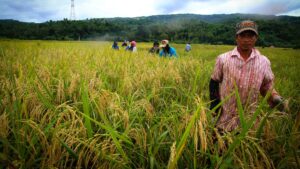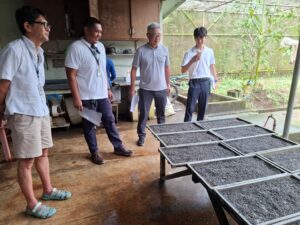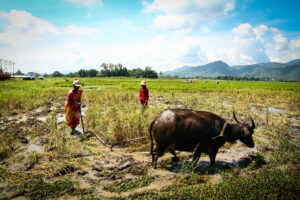by Shah-Al Emran, Timothy Krupnik, Sreejith Aravindakshan, Virender Kumar, and Cameron Pittelkow
The government of Bangladesh has supported land-use intensification, with an initial focus on rice which now covers 78% of total arable land. While this helped Bangladesh achieve self-sufficiency in rice production, policymakers have long understood the negative effects of rice-based systems on water consumption, carbon and energy footprints, and loss of diversity in crops and wildlife. Hence, the government proposed a crop diversification policy as early as 1989. This study conducted a multi-criteria assessment of coastal smallholder cropping systems in southern Bangladesh to investigate opportunities for improving the dominant current system of low-input, low-productivity aman-season rice.
Agricultural intensification is the process of increasing crop productivity per unit area, which can either include higher yields for a single crop or higher system productivity by growing multiple crops per year on the same land (i.e., higher cropping intensity). In some of South Asia’s most productive agricultural systems, cropping system intensification has occurred through growing multiple cereal crops within a year, such as in the irrigated rice-wheat cropping systems of the Indo-Gangetic plain or triple rice cropping systems in Vietnam.
However, the intensification of cereal systems is often associated with higher inputs of nutrients, water, agrichemicals, labor, and energy leading to major environmental concerns including high carbon footprints and low nutrient and energy use efficiencies. Consequently, attention is now being directed toward developing cropping systems with more favorable effects on the environment, particularly through increasing the diversity of crops grown.
Crop diversification represents a key pathway for improving sustainability, where multiple species or crop types are grown in rotation in different seasons within the same calendar year. Research has shown this can provide numerous benefits, including increased productivity, enhanced nitrogen use efficiency, and lower carbon footprints, in addition to enhancing other ecosystem services.
These criteria are, however, not necessarily the most crucial for smallholder farming systems struggling with poverty and limited resources. Changes in cropping systems that compromise economic profitability or farm-level efficiencies of labor, fertilizer, or energy are not desirable. Thus, research must account for a range of sustainability indicators and their potential synergies and trade-offs, ideally under representative constraints and conditions for smallholders. For rice-wheat and continuous rice cropping systems, experimental studies have a long history of comparing alternative sequences of different cultivated species to examine diversification options.
Conversely, much less information is available from on-farm studies considering what crop sequences provide the best opportunities for increasing system performance across multiple indicators to balance the objectives of economic profitability, food production, and efficient resource use in smallholder systems.
A small country of just 143,570 square km, Bangladesh has one of the world’s most dense populations with 163 million people. To feed the projected population of 185 million by 2030, Bangladesh will need to increase food production by 17% to achieve national food security.
This demand puts immense pressure on the country’s already limited arable land area. Further conversion of non-agricultural land to farming is unlikely; thus, cropping system intensification is suggested as the most feasible pathway for increasing total food production.
Since its independence in 1971, the government of Bangladesh has supported land-use intensification, with an initial focus on rice which now covers 78% of total arable land. While this helped Bangladesh achieve self-sufficiency in rice production, policymakers have long understood the negative effects of rice-based systems on water consumption, carbon and energy footprints, and loss of diversity in crops and wildlife; hence, the government proposed a crop diversification policy as early as 1989.
Major crops grown in rotation with rice in Bangladesh are wheat, maize, potato, mustard, and winter vegetables using three cropping seasons (boro, pre-monsoon, and monsoon), but this is primarily in the northern and northeastern regions. In contrast, systems are less diversified in the Southcentral coastal zone, which consists primarily of one rice crop per year followed by a fallow season during the dry winter (boro season).
In this area, high and prolonged rainfall during the monsoon (aman) season, combined with the ebb and flow of tidal water movement into agricultural fields, forces farmers to rely on aman season rice as the cropping system base.
Three categories of aman season rice are cultivated depending on field landscape position and the corresponding level of water inundation a field experiences during the monsoon (i.e., flooding depth). Short-, medium-, and long-duration varieties are typically planted in high (0-–30-cm flooding depth), medium (medium-high and medium-low, 30–180 cm), and low (low and very low, >180 cm) landscape positions, respectively.
Due to climate risks and resource constraints, management of aman season rice is generally low input without irrigation, causing low average yields of 2.4 t/ha with a significant spatiotemporal variation.
During the dry winter season, farmers have the potential to grow additional crops in coastal areas. Currently, the government is promoting irrigated rice (boro season rice) to overcome the low cropping system intensity compared to other regions. Farmers also cultivate groundnut, chili, mungbeans, and lathyrus, each having different input requirements and economic outcomes.
However, we are not aware of research in Bangladesh quantifying how alternative crop sequences impact system performance in terms of agronomic, economic, and environmental indicators. Such holistic approaches are increasingly used to evaluate the sustainability of rice-based systems in other countries. Optimizing outcomes across indicators is often challenging due to conflicts between food production and environmental goals, highlighting the need to explicitly assess trade-offs.
When considering multiple crops in rotation, research should account for the management practices and inputs associated with each crop relative to their outputs, which dictates system-level resource-use efficiencies. For example, crops with lower inputs such as aman-season rice may result in high resource use efficiency depending on yield levels but whether this is also true for crops like mungbean and lathyrus remains unclear.
On the other hand, irrigated rice grown during the boro season requires a higher amount of fertilizers (NPK), labor, and fuel for irrigation. While these inputs contribute to higher grain yield, production costs are higher, which may influence profitability and decrease resource use efficiencies.
In this study, we conducted a multi-criteria assessment of coastal smallholder cropping systems in southern Bangladesh to investigate opportunities for improving the dominant current system of low-input, low-productivity aman-season rice.
Our objectives were to (a) evaluate synergies and trade-offs of different cropping systems on farm-level productivity and resource use efficiencies, (b) develop a multi-criteria performance index using seven indicators considering agronomic, environmental, and economic dimensions, and (c) explore the scope for improving farm-level yield and resource use efficiencies for individual compared to top-performing farmers.
Results show it is possible to increase productivity through higher cropping system intensity, but this comes with a cost of decreased resource use efficiencies and higher costs of production and climate risk, which can represent important trade-offs for smallholder farmers. However, crop diversification strategies with legumes resulted in a better balance of boosting food production without compromising environmental footprint, providing new insights for future research, extension, and policy in rice-based cropping systems.
Read the study:
Emran SA, Krupnik TJ, Aravindakshan S. et al. (2022) Impact of cropping system diversification on productivity and resource use efficiencies of smallholder farmers in south-central Bangladesh: a multi-criteria analysis. Agron. Sustain. Dev. 42, 78.





